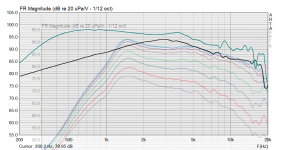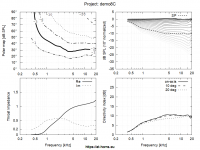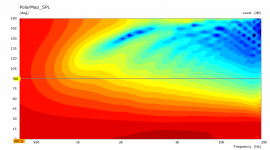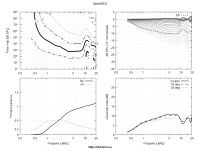I think the idea of incorporating the PWT data into the simulation is an interesting one... But only so far as it could make the Ath graphs look more like the measured graphs.
I tend to agree with mabat that it's not all that useful for designing the actual waveguide, however.
To be valuable at all, it would need to be incorporated along with an advanced LE model of the driver (and its phase plug), which is a huge undertaking in itself.
I tend to agree with mabat that it's not all that useful for designing the actual waveguide, however.
To be valuable at all, it would need to be incorporated along with an advanced LE model of the driver (and its phase plug), which is a huge undertaking in itself.
it's good to believe... it's different to prove...and just for clarity what makes you think the "wiggles" are due to throat wavefront mismatch and not something else?
Last edited:
for all we know it's due to diaphragm resonances...which is likely why some are hoping for the comparison of the same device on a plain wave tube ,no?
well that would depend on length of the tube and position of measuring elements would it not?
and sorry i've always wondered how a plain wave tube is in anyway similar to a horn as the frequency decreases?
and sorry i've always wondered how a plain wave tube is in anyway similar to a horn as the frequency decreases?
Last edited:
No, I don't think so.well that would depend on length of the tube and position of measuring elements would it not?
From the PWT we can find the average velocity at the aperture. This could be used in the sims to yield a better predicted response of the resulting system. But this only works for that portion of the wavefront that is flat, any variations of the velocity across the aperture would be averaged out. A flat wavefront would be the case at LFs, but will deviate from that at HFs. The extent of this deviation is unknown at this time.
Making my attempt at using this tool. I've chosen the dayton 1-1/8 inch al dome tweeter (hoping that the first breakup mode is high enough) its got an easily removable phase shield + grill so i'm hoping it is pretty close to the models
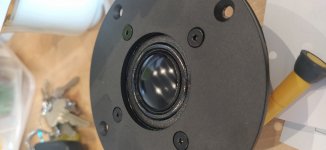
I'm hoping to get to 800-1khz at lowish volumes without breaking the bank (its about 100$ AU for a pair here)
modeled the diaphragm using the script. I used the 8C demo as a reference.
Started the print now on my cr10s, should be done in just 22 hours!
Will be doing some measurements tomorrow to see how it turns out. fingers crossed!
If it looks pretty good i'll be integrating it with my Behringer truths as the woofer to see how a complete system might sound. I'm really keen to compare it to something which is known to be pretty decent like that.
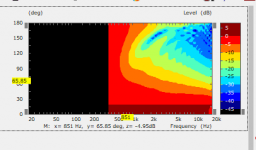
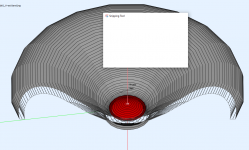
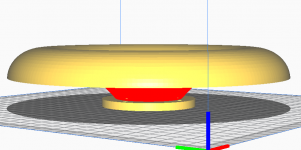
Here's the config i've made if anyone else wants to try something similar 🙂
View attachment demo8C.txt

I'm hoping to get to 800-1khz at lowish volumes without breaking the bank (its about 100$ AU for a pair here)
modeled the diaphragm using the script. I used the 8C demo as a reference.
Started the print now on my cr10s, should be done in just 22 hours!
Will be doing some measurements tomorrow to see how it turns out. fingers crossed!
If it looks pretty good i'll be integrating it with my Behringer truths as the woofer to see how a complete system might sound. I'm really keen to compare it to something which is known to be pretty decent like that.



Here's the config i've made if anyone else wants to try something similar 🙂
View attachment demo8C.txt
hmmm. clearly I should have been using the 2db plotting with the new tool. clearly could improve it. Mostly hoping that I get the extension out of it that the model shows. will clearly have to do a V2 though.
Thanks for clearing that up. So let me check if I get it right - in PWT, under the plane wave assumption, the particle velocity is directly proportional to pressure. So if I use velocity drive in the simulations, based on pressure in the tube, I can use this as an approximation for a particular driver (at lower frequencies). That should be no problem.From the PWT we can find the average velocity at the aperture. This could be used in the sims to yield a better predicted response of the resulting system. But this only works for that portion of the wavefront that is flat, any variations of the velocity across the aperture would be averaged out. A flat wavefront would be the case at LFs, but will deviate from that at HFs. The extent of this deviation is unknown at this time.
Last edited:
Very nice. Maybe I would try to aim for a lower DI with such a small waveguide (around 7 dB?). It would match better with a smaller woofer and made a more balanced DI curve overall.Making my attempt at using this tool. ...
Hmm, how is that, that this velocity is independent of a throat impedance? Doesn't the throat impedance affect excursion, etc.? I was under the impression that it does 😕... So if I use velocity drive in the simulations, based on pressure in the tube, I can use this as an approximation for a particular driver ...
Very nice. Maybe I would try to aim for a lower DI with such a small waveguide (around 7 dB?). It would match better with a smaller woofer and made a more balanced DI curve overall.
Ok cool 🙂 will factor this into the 2.0 attempt! was kind of hoping to get a slightly less 'live' sound in my room by sticking to the 90 deg. but will easily be able to compare with a 7db horn as well.
Yeah, but as seen from the DI curve it's not possible to control the directivity very low in freqency with such small device - it starts to widen below 3 kHz or so. Hence, IMHO, it's better to have it all wider.
Now I noticed you made the same mistake as almost everyone else - when simulating a dome tweeter, you have to set the axial velocity of the driving elements (the default is radial):
Source.Velocity = 2
Sorry for the bummer but this is the "correct" result:

It will be interesting to see the measured results anyway, as the simulation can still be way off the reality due to the non-pistonic movement of the diaphragm.
Source.Velocity = 2
Sorry for the bummer but this is the "correct" result:
It will be interesting to see the measured results anyway, as the simulation can still be way off the reality due to the non-pistonic movement of the diaphragm.
Attachments
Last edited:
- Home
- Loudspeakers
- Multi-Way
- Acoustic Horn Design – The Easy Way (Ath4)
